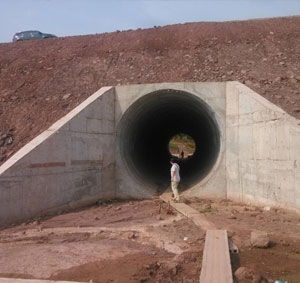Steel corrugated culverts, also known as metal corrugated culverts or corrugated culverts, are often installed in culverts under the fill section of highways and railways to replace circular culverts, concrete cover culverts or concrete arch culverts. Steel corrugated pipe culverts have great advantages under different geological conditions of mountain roads, such as strong foundation bearing capacity, low flatness requirements, strong ability to adapt to foundation deformation, convenient installation, and low engineering cost. However, during construction, there are often construction quality problems such as poor quality of gravel, gravel or coarse sand cushion layer laid on the bottom of the foundation, large particle size of gravel, gravel and other particles backfilled on the back of the culvert, and failure to strictly layer and symmetrical backfill, which can easily cause the steel corrugated pipe to deform due to stress concentration, resulting in quality defects such as dislocation of pipe sections, twisting and sinking of pipe walls, and falling off of splicing bolts. Therefore, it is necessary to take reinforcement measures for deformed steel corrugated pipes to prevent accidents such as pipe wall collapse.
Construction process
The construction process of deformation reinforcement of steel bellows is: survey and calculation → casing processing → casing installation → plugging end → preparing cement slurry → pipe grouting → pipe inspection.
Deformation reinforcement construction plan
Survey and calculation
The steel bellows with pipe section deformation are surveyed on site to detect the length of the deformation section and the size of the deformation to determine the length that needs to be reinforced with liner casing, and the minimum pipe diameter is checked according to the flow of the catchment area. According to the fill height on the top of the culvert, the highway Class I automobile load design and other parameters, in accordance with the requirements of the "General Technical Conditions for Metal Bellows Expansion Joints" (GB/T12777-2019), the ultimate bearing capacity of the steel bellows is verified.

Casing processing
According to the deformation of the 2m diameter assembled corrugated pipe at the construction site and the maximum drainage requirement, a 1.5m diameter prefabricated corrugated pipe customized by the manufacturer is selected as the inner lining casing. Its wave height is 55mm, wave distance is 200mm, material is Q235, wall thickness is 4mm, and the corrugated pipe sections are connected by internal flanges.
Casing installation
(1) Prefabricated pipe sections are used in the deformed corrugated pipe, and they are installed and checked in alignment with the central axis of the corrugated pipe. To ensure smooth drainage, the bottom of the inner casing overlaps smoothly with the original corrugated pipe, and there is no misalignment, thus avoiding water accumulation.
(2) The casing is supported symmetrically with wedge blocks, and diagonal braces are added for temporary support and stability; high-strength bolts are used to connect and tighten the flanges of adjacent pipe sections.
(3) The support plates at both ends of the inner casing are welded to the original culvert wall to ensure that the pipe sections are firmly supported in the cross-sectional direction to prevent the adjacent inner casing from moving and dislocating during subsequent construction. The wedge blocks and temporary diagonal braces are then removed.
(4) After the liner casing is connected and installed, spray asphalt on the casing wall for anti-corrosion treatment
Sealing the end
(1) After the liner casing is fully installed, seal the gap between the pipe opening at both ends of the casing and the deformed corrugated pipe wall. Use end steel plate welding to seal so that a closed cavity is formed between the two pipe walls.
(2) Use sealing materials to seal the end plate and the pipe wall, the overlap of the pipe bottom and the pipe joint bolt connection to prevent leakage during grouting.
Preparing cement slurry
The cement slurry is prepared according to the mix ratio of 1:1.0-1:1.2 determined by the laboratory. The cement slurry grade (strength of 4cmx4cmX16cm rectangular test block at 28d age) should not be lower than the concrete culvert wall grade (generally C25).
Pipeline grouting
(1) Start the grouting pump, adjust the grouting pressure, and inject the cement slurry into the cavity between the two pipes through the grouting pipe. According to the inlet and outlet direction of the corrugated pipe culvert, grouting is carried out in the order of first the two ends and then the middle, and first the lower layer and then the upper layer. After one section of grouting construction is completed, the next hole can be grouted.
(2) When the grouting pressure is ≥0.5MPa, the system automatically stabilizes the pressure for 3 minutes according to the preset program.
(3) After the first grouting is completed and solidified, the second grouting is carried out. After the grouting is completed, the construction site must be cleaned up in time.
(4) If there is leakage at the connection in the pipe cavity, a certain proportion of water glass can be added to the cement slurry to prevent leakage by double liquid grouting.
Pipeline inspection
After the cement slurry solidifies, the test instrument can be used to detect whether the cavity grouting between the inner lining casing and the original steel corrugated pipe is full and dense. There are two common methods: one is to use an acoustic parameter tester, that is, to use the acoustic wave scattering scanning method to perform ultrasonic testing on the cavity grouting area on both sides of the inner lining casing and the upper top pipe wall; the other is to use a channel grouting density quality tester, using impact elastic waves as the test medium, to quickly perform qualitative and positioning tests on the density quality of the cavity grouting of the inner lining corrugated pipe and the location of the non-dense area. Once the grouting is found to be non-dense, the grouting pipe should be used to perform grouting again to supplement the density.
Previous
None
Comments
Please Join Us to post.
0